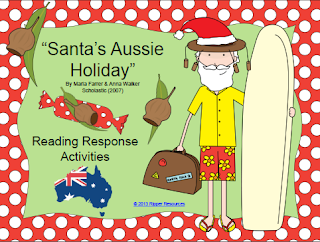My previous post introduced the book, "Downpour". You can read that post in my November blog post archive (right hand side of the blog - scroll down).
Our Summer storms are continuing in Queensland and there are two other picture books I am really enjoying. The first is called, "Rain Dance" by Cathy Applegate and Dee Huxley (2000). Set in the Australian outback, this is a beautiful picture book that brings to life the importance of rain to outback communities and the impact of drought. You can almost smell and feel the rain as it hits the parched earth in the outback. Dee Huxley's illustrations capture the terrain and colours of the outback so well. The author's text provides a visual image to support the illustrations (e.g. "Beyond our desolate farm I can see the horizon where a few dark clouds cruelly taunt us with promises of rain".) This would be a great mentor text for exploring descriptive and figurative language.
Teaching notes for teaching visual literacy using "Rain Dance" and other texts are available in the publication on the right. A free download of the contents page that shows the picture books examined is available by clicking on that image and then the link to see sample pages. There is a chapter in the book on the right on "In Flanders Fields" (by Norman Jorgenson and Brian Harrison-Lever) which is set in World War 1.
A companion text for "Rain Dance" is an Australian indigenous picture book, "Big Rain Coming" by Katrina Germein and one of my favourite indigenous illustrators, Bronwyn Bancroft. You can view a youtube reading of this title here or download teaching ideas here. This story is set in Katherine in the Northern Territory of Australia when people were experiencing severe drought and the anticipation of rain. Other teaching notes are available here.


These Australian indigenous titles about the importance of rain and the anticipation of rain could be compared and contrasted to picture books from other cultures with a similar theme, for example, "Sing Down the Rain" (1977) which is a poem about the annual Tohono O'odham saguaro harvest and rain-making ceremony. More information about this cultural ceremony can be read via the Southwest Cross-Cultural Wisdom Circle page. A choral reading script for this text is available here.
It would be interesting to compare and contrast the animals mentioned in "Rain Dance" and also in "Sing Down the Rain" as the latter mentions ciquadas, however in Australia we have cicadas - I am wondering if they are the same thing? Both texts also mention events and characters specific to the different cultures and contexts.

Another terrific picture book I have discovered recently is "The Rain Train" by Elena de Roo and Brian Lovelock (2010). This is a fantastic picture book for exploring onomatopoeia. You can almost hear and feel the rain as you read this picture book that tells the story of a train ride when the rain is pouring down. You can almost feel the drizzle and chill through the illustrations. Both the author and illustrator live in New Zealand.
Sometimes people live through droughts, wishing for rain and sometimes people experience too much rain and flooding. In the past two years, people in South-East Queensland have experienced flash flooding and the devastation of flood waters.
Two picture books that contrast representations of the experience of the Brisbane floods in January 2011 are Jackie French's "Flood" (illustrated by Bruce Whatley) and "Alex and the Watermelon Boat" by Chris McKimmie. Both represent the events in different ways. Figurative language could be explored using "Flood". Caution needs to be taken, however, when sharing these picture books with students from the communities affected, as it may actually foster memories of loss and grief, so teacher judgement (as always) would need to be exercised. Jackie French discusses "Flood" and how to handle some of these concerns here including students' positive reactions to the picture book ,which represents communities pulling together, survival and heroism. The illustrations certainly bring back memories of the drench, the mud and the generosity of the thousands of volunteers (the "Mud Army").
From a critical literacy stance, I think it is far more powerful to compare and contrast how authors and illustrators represent the same event in different ways, through multiple texts, rather than just focusing on the study of representation of a single text.
Please leave a comment if you know of any other texts that could be included in this text set, or if you have used any of the books mentioned in this blog post.
Now...next weekend is another huge giveaway of freebies from my friends who participated in the Super Sleuths blog hop last month...mark this in your diaries...my clip art has come and I am so excited about using it...so next weekend...don't miss "The Gift of Reading Blog Hop."
Many thanks

































